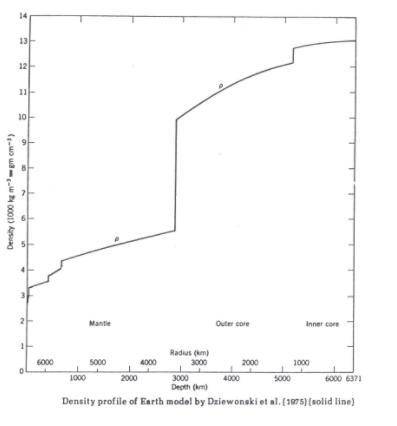
Physics, 18.03.2021 01:50 lovelyashjoy
Calculate the acceleration of gravity as a function of depth in the earth (assume it is a sphere). You may use an average density from the attached density profile for a spherical shell (which does not have to be very thin, for example, a shell from the inner core-outer core boundary to the middle depth of the outer core). Do not make the shell contains a large density contrast. Calculate enough points to make the g profile. Note that only the mass at radius less than r contributes to the gravitational acceleration. (15 points)

Answers: 1


Another question on Physics

Physics, 22.06.2019 02:50
Steam is generated in a boiler of a cogeneration plant at 10 mpa and 450°c at a steady rate of 5 kg/s. in normal operation, steam expands in a turbine to a pressure of 0.5 mpa and is then routed to the process heater, where it supplies the process heat. steam leaves the process heater as a saturated liquid and is pumped to the boiler pressure. in this mode, no steam passes through a condenser, which operates at 20 kpa. (a) determine the power produced in the turbine and the rate at which process heat is supplied in this mode. (b) determine the power produced in the turbine and the rate of process heat supplied if only 60 percent of the steam is routed to the process heater and the remainder is expanded to the condenser pressure. (3.32 mw; 9.69 mw; 4.25 mw; 5.82 mw)
Answers: 3

Physics, 22.06.2019 18:30
Ablock of mass m slides on a horizontal frictionless table with an initial speed v0 . it then compresses a spring of force constant k and is brought to rest. the acceleration of gravity is 9.8 m/s2. how much is the spring compressed x from its natural length? 1) x = v0*sqrt(k/(mg)) 2) x=v0*sqrt(m/k) 3) x=v0*((mk)/g) 4) x=v0*sqrt(k/m) 5) x=v0*(m/kg) 6) x=v0*sqrt((mg)/k) 7) x=(v0)^2/(2g) 8) x=v0*(k/(mg)) 9) x=(v0)^2/(2m) 10) x=v0*((mg)/k)
Answers: 3

Physics, 22.06.2019 21:00
Give me a example of a decomposer. explain what would happen if decomposers were absent from a forest ecosystem
Answers: 1

Physics, 22.06.2019 22:20
One hazard of space travel is debris left by previous missions. there are several thousand masses large enough to detect by radar orbiting the earth, but there are far greater numbers of very small masses such as flakes of paint. calculate the force exerted by a 0.110 mg chip of paint that strikes a space shuttle window at a relative speed of 5.00 ✕ 103 m/s and sticks, given the collision lasts 6.00 ✕ 10-8 s. such a collision chipped the window of the ill-fated challenger in june 1983, causing $50,000 of damage.
Answers: 2
You know the right answer?
Calculate the acceleration of gravity as a function of depth in the earth (assume it is a sphere). Y...
Questions


Mathematics, 12.07.2019 03:20

Health, 12.07.2019 03:20


Advanced Placement (AP), 12.07.2019 03:20


Mathematics, 12.07.2019 03:20

Mathematics, 12.07.2019 03:20






























